Dia Visiting Committee of European Sculpture and Decorative Arts Logo
 | |
 | |
| Established | 1885 |
|---|---|
| Location | 5200 Woodward Avenue Detroit, Michigan |
| Coordinates | 42°21′34″Northward 83°03′53″W / 42.35944°N 83.06472°W / 42.35944; -83.06472 Coordinates: 42°21′34″N 83°03′53″W / 42.35944°North 83.06472°Westward / 42.35944; -83.06472 |
| Type | Art museum |
| Collection size | 65,000 works[one] |
| Visitors | 677,500 (2015)[1] |
| Founder | Wilhelm Valentiner[i] |
| Manager | Salvador Salort-Pons |
| Public transit access | QLINE: Warren / Ferry DDOT, SMART |
| Website | www.dia.org |
| Detroit Found of Arts | |
| U.Due south. Historic district | |
| Built | 1927 |
| Architect | Paul Philippe Cret |
| Architectural fashion | Beaux-Arts, Italian Renaissance |
| Restored | 2007 |
| Restored by | Michael Graves |
| Part of | Cultural Center Historic Commune (ID83003791) |
| Designated CP | November 21, 1983 |
The Detroit Institute of Arts (DIA), located in Midtown Detroit, Michigan, has one of the largest and most significant art collections in the Usa. With over 100 galleries, it covers 658,000 square feet (61,100 yardtwo)[2] [3] with a major renovation and expansion project completed in 2007 that added 58,000 square feet (v,400 k2).[two] The DIA collection is regarded as among the top vi museums in the United States with an encyclopedic collection which spans the globe from ancient Egyptian and European works to contemporary fine art.[2] Its fine art collection is valued in billions of dollars, upwardly to $viii.1 billion according to a 2014 appraisal.[4] [5] The DIA campus is located in Detroit's Cultural Centre Celebrated District, about two miles (three km) north of the downtown area, across from the Detroit Public Library virtually Wayne State University.
The museum building is highly regarded by architects.[vi] The original building, designed past Paul Philippe Cret, is flanked by north and south wings with the white marble as the primary outside textile for the entire structure. The campus is part of the metropolis's Cultural Middle Historic District listed in the National Register of Historic Places. The museum's first painting was donated in 1883 and its collection consists of over 65,000 works. With about 677,500 visitors annually for 2015, the DIA is amidst the most visited art museums in the world.[i] [vii] The Detroit Institute of Arts hosts major fine art exhibitions; it contains a 1,150-seat theatre designed by architect C. Howard Crane, a 380-seat hall for recitals and lectures, an fine art reference library, and a conservation services laboratory.[one]
Collections [edit]

The museum contains 100 galleries of art from around the globe.[eight] Diego Rivera's Detroit Manufacture cycle of frescoes span the upper and lower levels to surround the central 1000 marble court of the museum. The armor drove of William Randolph Hearst lines the main hall entry way to the grand court. The drove of American fine art at the DIA is one of the near impressive, and officials at the DIA accept ranked the American paintings collection third amongst museums in the United states. Works by American artists began to be nerveless immediately following the museum'due south founding in 1883. Today the collection is a strong survey of American history, with acknowledged masterpieces of painting, sculpture, furniture and decorative arts from the 18th century, 19th century, and 20th century, with contemporary American art in all media too existence collected. The latitude of the drove includes such American artists as John James Audubon, George Bellows, George Caleb Bingham, Alexander Calder, Mary Cassatt, Dale Chihuly, Frederic Edwin Church, Thomas Cole, John Singleton Copley, Robert Colescott, Leon Dabo, Thomas Wilmer Dewing, Thomas Eakins, Childe Hassam, Robert Henri, Winslow Homer, George Inness, Martin Lewis, Georgia O'Keeffe, Charles Willson Peale, Rembrandt Peale, Tom Phardel, Duncan Phyfe, Hiram Powers, Sharon Que, Frederic Remington, Paul Revere, Augustus Saint-Gaudens, John Singer Sargent, John French Sloan, Tony Smith, Marylyn Dintenfass, Gilbert Stuart, Yves Tanguy, Henry Ossawa Tanner, Louis Condolement Tiffany, Andy Warhol, William T. Williams, Anne Wilson, Andrew Wyeth, and James McNeill Whistler.

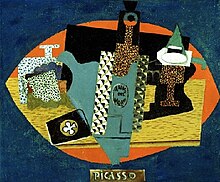
Pablo Picasso, 1916, 50'anis del mono (Bottle of Anis del Mono), oil on sail, 46 x 54.half-dozen cm
The early 20th century was a period of prolific collecting for the museum, which acquired such works as a dragon tile relief from the Ishtar Gate of Babylon, an Egyptian relief of Mourning Women and a statuette of a Seated Scribe, Pieter Bruegel the Elder's The Wedding Trip the light fantastic toe, Saint Jerome in His Report by Jan van Eyck and Giovanni Bellini'southward Madonna and Child. Early purchases included French paintings by Claude Monet, Odilon Redon, Eugène Boudin, and Edgar Degas, as well as Quondam Masters including Gerard ter Borch, Peter Paul Rubens, Albrecht Dürer and Rembrandt van Rijn. The museum includes works past Vincent van Gogh including a self-portrait. The self-portrait of Vincent van Gogh and The Window past Henri Matisse were purchased in 1922 and were the first paintings past these 2 artists to enter an American public collection. Afterward important acquisitions include Hans Holbein the Younger'due south Portrait of a Woman, James Abbott McNeill Whistler'southward Nocturne in Blackness and Gold: The Falling Rocket, and works past Paul Cézanne, Eugène Delacroix, Auguste Rodin, Jean-Baptiste Carpeaux and François Rude. High german Expressionism was embraced and collected early past the DIA, with works past Heinrich Campendonk, Franz Marc, Karl Schmidt-Rottluff, Max Beckmann, Karl Hofer, Emil Nolde, Lovis Corinth, Ernst Barlach, Georg Kolbe, Wilhelm Lehmbruck, Erich Heckel, Ernst Ludwig Kirchner, Paula Modersohn-Becker, and Max Pechstein in the collection. Non-German artists in the Expressionist motility include Oskar Kokoschka, Wassily Kandinsky, Chaïm Soutine and Edvard Munch. The Nut Gatherers by William-Adolphe Bouguereau is, by some accounts, the most popular painting in the collection.
In addition to the American and European works listed higher up, the collections of the Detroit Institute of Arts are more often than not encyclopedic and extensive, including ancient Greek, Roman, Etruscan, Mesopotamian, and Egyptian cloth, besides as a wide range of Islamic, African and Asian art of all media.
In December 2010, the museum debuted a new permanent gallery with special collections of manus, shadow, and string puppets along with programmable lighting and original backgrounds. The museum plans to feature boob related events and rotation of exhibits fatigued from its puppet collections.[ix]
Exhibitions [edit]

The main hall of the DIA leading to the Rivera Court


Hall between old and new sections
Artists' Take on Detroit: Projects for the Tricentennial (Oct 19, 2001 – December 28, 2001) This exhibit celebrates Detroit'south 300th anniversary by creating 10 projects that represent the city. The installations created by 15 artists include video and nonetheless photography, text and sound, and sculptures. This exhibit includes the post-obit: Altar Mary by Petah Coyne, Strange Früt: Rock Apocrypha by Destroy All Monsters Collective, Traces of Then and Now by Lorella Di Cintio and Jonsara Ruth, Fast Frontward, Play Back past Ronit Eisenbach and Peter Sparling, Riches of Detroit: Faces of Detroit by Deborah Grotfeldt and Tricia Ward, Open Firm past Tyree Guyton, A Persistence of Memory past Michael Hall, Relics by Scott Hocking and Clinton Snider, Blackout by Mike Kelley, Voyageurs by Joseph Wesner [10]
Fine art in Focus: Celadons (January sixteen – April fourteen) Green-glazed ceramics, also known as celadon ware, created by Suzuki Sansei are on brandish in each of the Asian galleries. [xi]
Over the Line: The Art and Life of Jacob Lawrence (Feb 24, 2002 – May 19, 2002) The exhibit contains work of the African American artist Jacob Lawrence (1917–2000), and includes never earlier seen pieces from the Migration and the John Brownish series. [12] [13]
Degas and the Dance (Oct xx, 2002 – January 12, 2003) This exhibit includes more than 100 pieces of work created by Edgar Degas. These pieces include model stage sets, costume designs, and photographs of the dancers from the 19th-century Parisian ballet. [14]
Magnificenza! The Medici, Michelangelo and The Fine art of Belatedly Renaissance Florence (March 16, 2003 – June 8, 2003) The exhibit displays art of the cultural successes of the first four Medici grand dukes of Tuscany during 1537–1631, along with their connectedness with Michelangelo and his art in the Belatedly Renaissance Florence. [15]
When Tradition Inverse: Modernist Masterpieces at the DIA (June 2003 – August 2003) This showroom simply contains pieces from the DIA's collection from the tardily 19th-century and early 20th-century and displays the dissimilar choices artists expressed themselves after 1900. [16]
And so and Now: A selection of 19th- and 20th-Century Art by African American Artists (July 2003 – August 2003) Roughly 40 objects in this exhibit, organized past the General Motors Centre for African American Fine art, brandish the artistic styles of African American artists during the by two hundred years. This exhibit includes work from Joshua Johnson, Robert Scott Duncanson, Henry Ossawa Tanner, Augusta Brutal, Benny Andrews, Betye Saar, Richard Chase, Sam Gilliam, and Lorna Simpson. Allie McGhee, Naomi Dickerson, Lester Johnson, Shirley Woodson, and Charles McGee are some of the Detroit artists that were included in the installation. [17]
Art in Focus: Buddhist Sculpture (Through July 14, 2003) This exhibit contains i Buddhist sculpture in each of the Asian galleries. These sculptures symbolize enlightenment, selflessness, wisdom and tranquility. [eighteen]
Yoko Ono's Freight Railroad train (September 17, 2003 – July 19, 2005) Freight Train, constructed by Yoko Ono in 1999, is a German language boxcar with bullet holes and is set on a section of railroad runway displayed outdoors. [19] [20]
Fine art in Focus: Mother-of-Pearl Inlaid Lacquer (Through October xiii, 2003) This exhibit contains lacquer wares made from sap of lacquer copse. [21]
Style of the Century: Selected Works from the DIA'southward Collection (Through Oct 27, 2003) [22]
Some Fluxus: From the Gilbert and Lila Silverman Fluxus Drove Foundation (Through October 28, 2008) The exhibit contains works from the Fluxus grouping, named by artist and provocateur George Maciunas. [23]
Dance of the Forest Spirits: A Prepare of Native American Masks at the DIA (Through October 6, 2003) Wooden masks made in the 1940s to represent the spirit world fabricated by the Kwakwaka'wakw (Native Americans of the Northwest declension) are displayed in the exhibit, forth with interactive videos, listening stations, and calculator activities. [24]
Dawoud Bey: Detroit Portraits (Apr four, 2004 – Baronial 1, 2004) Dawoud Bey'due south piece of work created during a five-week residency at Chadsey High Schoolhouse includes large-format, color photographic portraits along with a video of students from Chadsey High School is displayed in this exhibit. Selected artwork of students from writing and fine art workshops that are conducted past Bey and the art kinesthesia at Chadsey and behave give-and-take will also exist displayed. [25]
Pursuits and Pleasures: Baroque Paintings from the Detroit Establish of Arts (April 10, 2004 – July 4, 2004) Pieces of piece of work by Aelbert Cuyp, Giovanni Paolo Panini, Jacob van Ruisdael, Mathieu le Nain, Claude Lorrain, Gerard Ter Borch, Frans Snyders, and Thomas Gainsborough are displayed in this showroom, organized by the Kresge Art Museum, the Dennos Museum Center, the Kalamazoo Institute of Arts, and the Muskegon Museum of Art, along with the Detroit Institute of Arts. [26]
The Etching Revival in Europe: Late Nineteenth- and Early on- Twentieth Century French and British Prints (May 26, 2004 – September nineteen, 2004) Examples of etching piece of work of James McNeill Whistler, Francis Seymour Haden, Charles Meryon, Édouard Manet, Jean-François Millet, and Frank Brangwyn are displayed in this exhibit. [27]
The Photography of Charles Sheeler: American Modernist (September 8, 2004 – December 5, 2004) Prints from Charles Sheeler'south major series are displayed in this exhibit, including images of his house and barns in Doylestown, Pennsylvania captured in 1916 and 1917; stills from the 1920 picture show Manhatta; photographs of Chartres Cathedral taken in 1929; and images of American industry created in the 1930s for Fortune magazine. Likewise displayed are Sheeler's views from the Ford Motor Visitor's River Rouge complex commissioned by Edsel Ford in 1927. [28]
Murano: Drinking glass From the Olnick Spanu Collection (December 12, 2004 – Feb 27, 2005) The exhibit displays about 300 Venetian diddled drinking glass pieces made in the 20th-century, organized in chronological club. [29]
Gerard ter Borch (February 27, 2005 – May 22, 2005) The exhibit contains paintings of the 17th-century Dutch life created by Gerard ter Borch. [thirty]
Beyond Big: Oversized Prints, Drawings and Photographs (March 16, 2005 – July 31, 2005) The showroom displays large prints, drawings, and photographs past Abelardo Morrell, Anna Gaskell, Jenny Gage, Justin Kurland, Gregory Crewdson, Richard Diebenkorn, Jasper Johns, Robert Rauschenber, Judy Pfaff, Charles Burchfield, and others. [31]
Sixty-8th Annual Detroit Public Schools Pupil Exhibitions (Apr nine, 2005 – May 14, 2005) Kindergarten through 12th form students will have their work displayed at the Detroit Public Library because of renovations at the DIA. This exhibit contains hundreds of ceramics, paintings, drawings, sculptures, and videos. [32]
Camille Claudel and Rodin: Fateful Encounter (October nine, 2005 – February 5, 2006) The showroom contains work by Auguste Rodin and Camille Claude. 60-two sculptures past Claudel and fifty-eight by Rodin created before the two artists met along with sculptures created during the proficient and bad years of their human relationship are displayed. Some works created past Claudel that will be displayed include Sakuntala, The Flit, La Petite Châtelain, The Age of Maturity, The Wave, and Vertumnus and Pomona. Works of Rodin that volition be displayed include Bust of Camille Claudel, Saint John the Baptist Preaching, Balzac, and The Gates of Hell. [33]
African American Art from the Walter O. Evans Collection (April 9, 2006 – July ii, 2006) Selected pieces in various media from Walter O. Evan'southward individual collection will be displayed in the exhibit. Work by African American artists during the 19th and 20th centuries including Henry Ossawa Tanner, Edmonia Lewis, Elizabeth Catlett, Aaron Douglas, Romare Bearden, and Jacob Lawrence will be displayed also. [34]
Sixty-Ninth Annual Detroit Public Schools Student Exhibit (April xx, 2006 – May 14, 2006) Kindergarten through twelfth grade students will have their work displayed at the Detroit Public Library because of renovations at the DIA. This exhibit contains ceramics, drawings, collages, jewelry, and more than. [35]
Contempo Acquisitions: Prints, Drawings, and Photographs (May 17, 2006 – July 31, 2006) The exhibit contains works from the 1500s through the 2000s including prints by artists such as Giorgio Ghisi, Judy Pfaff, Terry Winters, and drawings by Adolph Menzel, and Stephen Talasnik. Work by early on 20th-century photographers by Edwin Hale Lincoln, Alvin Langdon Coburn, and Tina Modotti are displayed. Piece of work by gimmicky artists Larry Fink, Candida Hofer, and Kiraki Sawi are also displayed. [36]
The Big Three in Printmaking: Dürer, Rembrandt and Picasso (September thirteen, 2006 – December 31, 2006) The showroom features work of Dürer in the early 16th century, Rembrandt in the mid-17th century, and Picasso in the 20th century made of various media including wood and linoleum cuts, engraving, etching, aquatint, drypoint and lithography. [37]
Annie Leibovitz: American Music (September 24, 2006 – January 7, 2007) Annie Leibovitz'southward photographs of legends of roots music and younger artists influenced by them are displayed in the exhibit. Seventy portraits of hers are displayed in the showroom, including B.B. King, Johnny Greenbacks and June Carter, Willie Nelson, Pete Seeger, Etta James, Dolly Parton, Beck and Bruce Springsteen, Eminem, Aretha Franklin, Iggy Pop, Patti Smith, and The White Stripes. [38]
Ansel Adams (March iv, 2007 – May 27, 2007) The exhibit contains over 100 blackness and white photographs taken past Ansel Adams ranging from the early 1900s to the 1960s. This exhibit contains photographs of landscapes, Pueblo Indians, mountain views, along with portraits of his friends Georgia O'Keeffe, John Marin, and Edward Weston. [39]
Seventieth Almanac Detroit Public Schools Educatee Exhibition (March 31, 2007 – May 5, 2007) Kindergarten through 12th grade students will have their work displayed at the Detroit Public Library because of renovations at the DIA. This exhibit contains ceramics, drawings, collages, jewelry, and more. [40]
The Best of the All-time: Prints, Drawings, and Photographs from the DIA Collection (Nov 23, 2007 – March two, 2008) The DIA has chosen over 100 of the "best" prints, drawings, and photographs out of the museums 35,000 pieces of work to exist displayed in the exhibit. Some pieces that will exist displayed are Michelangelo'south double-sided chalk and pen and ink drawing of 1508 showing ornament schemes for the Sistine Chapel ceiling; Russet Landscape by Edgar Degas from the 1890s; and Wheels by Charles Sheeler in 1939. [41]
Compages [edit]

Detroit Establish of Arts
Before 1920, a commission was established to cull an architect to pattern a new edifice to business firm the DIA'southward expanding collections. The commission included DIA President Ralph H. Berth, William J. Gray, architect Albert Kahn and industrialist Edsel Ford. Due west.R. Valentiner, the museum director acted as art managing director and Clyde H. Burroughs was the secretary. The grouping chose Philadelphia builder Paul Philippe Cret as the atomic number 82 builder and the firm of Zantzinger, Borie and Medary equally associated architects, with Detroit architectural firms of Albert Kahn and C. Howard Crane contributing "advice and suggestions."[42]
The cornerstone for new Beaux-Arts, Italian Renaissance styled edifice was laid June 26, 1923 and the finished museum was dedicated October 7, 1927.[43]
In 1922, Horace Rackham donated a casting of Auguste Rodin's sculpture, The Thinker, acquired from a German drove, to the museum where it was exhibited while the new building was under construction. The work was placed in the Keen Hall of the new museum building. Sometime in the subsequent years the work was moved out of the edifice and placed on a pedestal in front of the building, facing Woodward Avenue and the Detroit Public Library beyond the street which was as well constructed of white marble in the Beaux-Arts, Italian Renaissance style .

The Gothic Chapel, as viewed in 1929
The s and north wings were added in 1966 and 1971 respectively. Both were designed by Gunnar Birkerts and were originally faced in black granite to serve as a backdrop for the original white marble building. The south fly was later named in award of museum benefactors Edsel and Eleanor Ford and the due north wing for Jerome Cavanaugh who was Detroit Mayor during the expansion.[43] [44]
The building also incorporates a 16th-century French Gothic chapel, donated by Ralph H. Berth.[45]
William Edward Kapp, builder for the firm of Smith, Hinchman & Grylls has been credited with interior design work on the Detroit Institute of Art.[46]
Artwork [edit]

Edsel Ford commissioned murals by Diego Rivera for DIA in 1932.[47] [48] Composed in fresco mode, the v sets of massive murals are known collectively as Detroit Industry, or Man and Machine.[49] The murals were added to a big primal courtyard; it was roofed over when the work was executed. The Diego Rivera murals are widely regarded as great works of art and a unique characteristic of the museum.[fifty] Architect Henry Sheply, a close friend of Cret's would write: "These [murals] are harsh in color, scale and limerick. They were designed without the slightest idea given to the frail architecture and decoration. They are quite simply a travesty in the name of art."[51] Their politically charged themes of proletariat struggle caused lasting friction betwixt admirers and detractors.[52] During the McCarthy era, the murals survived only past means of a prominent sign which identified them as legitimate art; the sign further asserted unambiguously that the political motivations of the creative person were "insufferable".[48] Today the murals are celebrated equally ane of the DIA'south finest assets, and fifty-fifty "one of America's most significant monuments".[53]
The building also contains intricate iron work by Samuel Yellin, tile from Pewabic Pottery, and architectural sculpture by Leon Hermant.[42]
Renovation and expansion [edit]
In November 2007, the Detroit Constitute of Arts building completed a renovation and expansion at a total cost of $158 million. Architects for the renovation included the Driehaus Prize winner Michael Graves and associates forth with the SmithGroup.[54] The projection, labeled the Main Plan Project, included expansion and renovation of the due north and southward wings besides as restoration of the original Paul Cret building, and added 58,000 boosted square feet, bringing the total to 658,000 foursquare feet.[2] The renovated exterior of the north and south wings was refaced with white marble acquired from the aforementioned quarry as the marble on the chief building designed by Paul Cret.[54] The major renovation of the Detroit Institute of Arts has provided a meaning example of report for museum planning, part, direction, and pattern.[55]
History [edit]

Detroit Institute of Arts
The Museum had its genesis in an 1881 tour of Europe made by local newspaper magnate James E. Scripps. Scripps kept a journal of his family'south five-calendar month tour of art and civilization in Italy, French republic, Federal republic of germany, and the Netherlands, portions of which were published in his paper The Detroit News. The series proved so popular that it was republished in book course called V Months Abroad. The popularity inspired William H. Brearley, the manager of the newspaper's advertising department to organize an fine art exhibit in 1883, which was also extremely well received.
Brearly convinced many leading Detroit citizens to contribute to establish a permanent museum. It was originally named the Detroit Museum of Art. Among the donors were James East. Scripps, his brother George H. Scripps, Dexter M. Ferry, Christian H. Buhl, Gen. Russell A. Alger, Moses Due west. Field, James McMillan and Hugh McMillan, George H. Hammond, James F. Joy, Francis Palms, Christopher R. Mabley, Simon J. Murphy, John Southward. Newberry, Cyrenius A. Newcomb, Sr., Thomas West. Palmer, Philo Parsons, George B. Remick, Allan Shelden, William C. Weber, David Whitney Jr., George Five. N. Lothrop, and Hiram Walker.
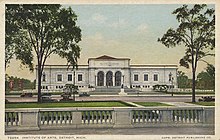
Detroit Institute of Arts, circa 1910s
With much success from their first exhibit, Brearley then challenged 40 of Detroit'due south leading and prominent businessmen to contribute $1,000 each to help fund the building of a permanent museum. With $fifty,000 coming from Scripps lonely, their goal was within reach. By 1888, Scripps and Brearley had incorporated Detroit Museum of Arts, filling it with over 70 pieces of artwork acquired by Scripps during his time in Europe.[56]
Lasting as a museum less than 40 years, the bear upon the museum had on the city of Detroit was tremendous. The Art Loan Exhibition's success in 1883 had led to the creation of a board. The purpose of the lath was to raise and establish funds to build a permanent art museum in the city. Donating money to the cause were some of Detroit's biggest names, including James E. Scripps, George H. Scripps, Russell A. Alger, and Sen. Thomas Palmer. The quondam Detroit Museum of Art building opened in 1888 at 704 Eastward. Jefferson Avenue (information technology was finally demolished in 1960). The Detroit Museum of Fine art board of trustees changed the name to the Detroit Found of Arts in 1919 and a committee began raising funds to build a new location with Scripps still at the captain. The present DIA building on Woodward Artery debuted on Oct 7, 1927. While not officially declared the founder of the Detroit Institute of Arts, Scripps and Brearley were indeed the founders of the DIA'south predecessor, The Detroit Museum of Fine art. With the success of the arts, and the booming machine industry, families were flocking to the city; pushing for the demand to expand the vision that Scripps had originally dreamed, a new building was raised and the DIA was born.
Some other conclusion in 1919 that would have a lasting bear upon on the future of the museum was transferring ownership to the City of Detroit with the museum becoming a city department and receiving operating funds. The board of trustees became the Founder's Society a private back up group that provided additional money for acquisitions and other museum needs. The museum sought the leadership of German language art scholar Wilhelm Valentiner. It every bit under Valentiner'southward leadership as director that, the museum flush with money from a booming metropolis and wealthy patrons, the size and quality of the DIA's collections grew significantly. The DIA became the first U.S. museum to larn a van Gogh and Matisse in 1922 and Valentiner'southward relationship with German language expressionist led to significant holdings of early Modernist art.[57]
Valentiner too reorganized how art was displayed at the museum. Breaking with the tradition of organizing artworks by their type with, for example, painting grouped together in one gallery and sculpture in another. Valentiner organized them by nation and chronology, this was recognized every bit being so revolutionary that the 1929 Encyclopædia Britannica used an analogy of the chief floor plan of the DIA every bit an example of the perfect modern fine art museum.[57]
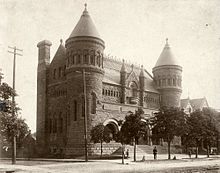
The old Detroit Museum of Art stood at 704 E. Jefferson Ave. The building opened in 1888
Support for the museum came from Detroit philanthropists such as Charles Lang Freer, and the car barons: art and funds were donated past the Dodges, the Firestones and the Fords, especially Edsel Ford and his married woman Eleanor, and subsequently their children. Robert Hudson Tannahill of the Hudson's Department Shop family unit, was a major benefactor and supporter of the museum, altruistic many works during his lifetime. At his death in 1970, he ancestral a large European art collection, which included works by Paul Cézanne, Vincent van Gogh, Paul Gauguin, Edgar Degas, Georges Seurat, Henri Rousseau, Henri Matisse, Pablo Picasso, Constantin Brâncuși, important works of German language Expressionism, a large collection of African fine art, and an endowment for future acquisitions for the museum. Role of the current support for the museum comes from the country regime in exchange for which the museum conducts statewide programs on art appreciation and provides art conservation services to other museums in Michigan.

In 1949, the museum was amid the commencement to return a piece of work that had been looted past the Nazis, when it returned Claude Monet'south The Seine at Asnières to its rightful owner. The art dealer from whom they had purchased it reimbursed the museum. In 2002, the museum discovered that Ludolf Backhuysen's A Man-O-War and Other Ships off the Dutch Declension, a 17th-century seascape painting nether consideration for purchase past the museum, had been looted from a individual European collection by the Nazis. The museum contacted the original owners, paid the rightful restitution, and the family unit allowed the museum to accession the painting into its collection, calculation another painting to the museum'southward already prominent Dutch collection. In another case, Detroit Institute of Arts v. Ullin, which involved a claim concerning Vincent van Gogh's "Les Becheurs (The Diggers)" (1889), the museum successfully asserted that Michigan'due south iii-year statute of limitations precluded the courtroom or a jury from deciding the merits of the case.[58]
The museum was expanded with a south and north fly in 1966 and 1971, respectively, giving infinite for the museum to receive two large gifts in 1970, the drove of Robert Tannahill and Anna Thompson Dodge ancestral the 18th-century French contents of the music room from her home, Rose Terrace, to the museum upon her death.[57]
As the fortunes of the city declined in the 1970s and 80s and then did its power to support the DIA. In 1975, even with reduced staff, the city was forced to shut the museum for 3 weeks in June. The Country of Michigan provided funding to reopen and over this time period the state would play an increasing function in funding the museum.[57]
A 1976 gift of $1 million from Eleanor Ford created the Department of African, Oceanic and New World Cultures.[44]
Past 1990, 70 percentage of the DIA's funding was coming from the Land of Michigan, that yr the state facing a recession and budget deficit cut funding past more than l percent. This resulted in the museum having to close galleries and reduce hours, a fundraising campaign led by Joseph 50. Hudson was able to restore operations.[57]
In 1998, the Founder'due south Society signed an operating agreement with the Metropolis of Detroit that would have the Founder'south Club operating as Detroit Found of Arts, Inc take over management of the museum from the Fine art Section with the metropolis retaining ownership of the DIA itself.[57]
On February 24, 2006, a 12-yr-sometime male child stuck a piece of chewing gum on Helen Frankenthaler'due south 1963 abstract piece of work The Bay, leaving a small stain. The painting was valued at $1.5 one thousand thousand in 2005, and is one of Frankenthaler's almost of import works. The museum'southward conservation lab successfully cleaned and restored the painting, which was returned to the gallery in belatedly June 2006.[59]
As part of the settlement of the City of Detroit'southward bankruptcy, buying of the museum was transferred to Detroit Institute of Arts, Inc., in December 2014, returning the museum to its pre-1919 status as an contained non-profit.[57]
Selections from the permanent drove [edit]
-
-

-
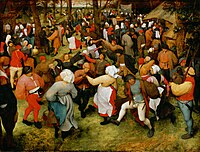
-
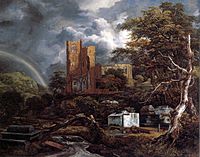
-
-

-
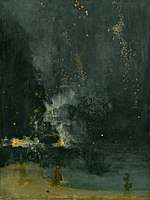
-

-

-
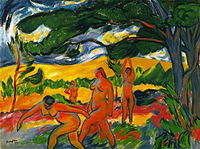
Max Pechstein, 1911, Under the Trees (Akte im Freien), oil on canvas, 73.6 x 99 cm (29 x 39 in)
-

Governance [edit]
Managing director [edit]
The current director of the Detroit Found of Arts, Salvador Salort-Pons a native of Madrid was previously head of the European Art Department at the DIA. Earlier coming to the DIA he was senior curator at the Meadows Museum at SMU and prior to that an banana professor of art history at the Complutense University of Madrid. Salort-Pons holds a doctorate in art history from the Purple Castilian College at Italia'south University of Bologna and an MBA from the Cox School of Business at Southern Methodist Academy in Dallas. On September sixteen, 2015, Salort-Pons was named as director following the retirement of Graham Aggravate in June.[sixty]
Criticism of Salort-Pons [edit]
Despite the increase in yearly visitors to the DIA, in that location is criticism that Salort-Pons is straying away from the "visitor-centered" philosophy pioneered past predecessor Graham Aggravate. Under this philosophy, the museum would brand the fine art and interpretations of art more than accessible to the general public to assistance them learn and connect with the pieces on display.[61] Salort-Pons' Spanish origin has made critics believe he is unable to understand and tackle the complexity of bug surrounding race, inclusivity, and representation in the United States. The New York Times reported that Salort-Pons was taking steps to ameliorate diversity despite his express understanding of the Black struggle in America.[62] In an interview with Artnet News, Salort-Pons said the commitment to better diversity in the DIA included "implementing diversity and customs engagement initiatives likewise every bit hiring qualified POC candidates.[63] Even so, several POC candidates who were hired by Salort-Pons, such as Lucy Mensah, banana curator of gimmicky fine art in 2017, resigned due to a "toxic work environment" and believed they were "token hires" because the DIA "premise some of their hires equally a way of diversifying the voices of the institution, but at the same time they don't really appreciate those voices."[64]
Controversy Over 2019 "Apprehensive and Human" Exhibition
Calls for greater racial sensitivity and honest interpretations of fine art suitable for immature patrons came after Paul Gauguin'southward painting "Spirit of the Dead Watching" was included in the multi-gallery show. The painting depicted a 13-year-quondam Tahitian girl named Teha'amana, who Gauguin took as his wife, naked on a bed. Gauguin was 44 years former.[63] In June 2020, former DIA digital experience designer Andrea Montiel de Shuman, a Mexican adult female, published an essay online announcing her resignation, citing "Spirit of the Dead Watching" as an example of the museum'due south sub-par date with nonwhite audiences.[65] Montiel de Shuman claimed the artworks' label did not address the possibility that the artist sexually abused her, gave her syphilis, and colonized her abode. Montiel de Shuman, in an email to the Detroit Gratis Press, said "[I] asked how the DIA was preparing front-line staff to handle conversations around power dynamics, colonial corruption, and sexual assault - particularly of minors."[65] The museum did not publicly respond to Montiel de Shuman's resignation, simply releasing a general argument that they "[do] non make media statements regarding private employment matters."[65]
Marketing [edit]
Besides property major art exhibitions inside the museum'due south ane,150-seat theatre and annual formal entertainment fundraising galas such as Les Carnavel des ArtStars in November,[66] [67] other Detroit Institute of Arts coordinated events include the annual "Fash Fustigate," a leading corporate sponsored style event, featuring celebrities and models that showcase the latest mode trends, typically held in the Renaissance Center's Winter Garden, the Fox Theatre, or at the Detroit Institute of Arts theatre in August to gloat Detroit Fashion Week.[68] [69] A 2012 survey showed 79 percent of the constitute's annual visitors lived in ane of the iii surrounding counties Wayne (which includes Detroit), Macomb, and Oakland.[lxx] The museum'south annual attendance was 429,000 in 2011 and rose to 594,000 in 2013.[71] In 2014, the museum'south almanac omnipresence was most 630,000.[1]
Finance [edit]
1 of the largest, nigh significant art museums in the United states, the Detroit Constitute of Arts relies on private donations for much of its financial support. The museum has sought to increase its endowment remainder to provide it financial independence. The City of Detroit owns the museum building and collection, only withdrew the city's financial back up. The museum's endowment totaled $200 1000000 in 1999 and $230 million in 2001. The museum completed a major renovation and expansion in 2007. By 2008, the museum's endowment reached $350 1000000; however, a recession, reduced contributions, and unforeseen costs reduced the endowment remainder to disquisitional levels.[66]
In 2012, the endowment totaled $89.3 million and provided an annual return of about $3.iv meg in investment income; while admissions, the museums cafe eatery, and trade and book sales from the museum's gift shop generated about $3.5 one thousand thousand a year, or just 15 pct of the annual budget. The museum raised $threescore million from 2008 to 2012, reduced staffing, and reduced its annual operating budget from $34 million in 2008 to 25.four one thousand thousand in 2012.[66] [70] In 2012, voters in iii of the major metropolitan counties approved a property tax levy or millage for a duration of 10 years, expected to raise $23 million per year, saving the museum from cuts. In August 2012, the museum website expressed appreciation to the voters for their back up. The Museum offers Wayne, Oakland, and Macomb County residents free full general admission for the 10-year duration of the millage approved in 2012.[72] In 2012, the museum established an updated fund raising goal for its endowment balance to reach $400 meg by 2022 in order to be self-sustaining, while the millage is in effect.[seventy] [73]
The DIA art drove is valued in billions of dollars, up to $8.5 billion according to a 2014 judge.[4] [5] After metropolis's defalcation filing July 18, 2013, creditors targeted a function of the museum'south collection that had been paid for with metropolis funds as a potential source of revenue. State-appointed emergency manager Kevin Orr hired Christie's Auction House to assess the collection. After months of determining the fair market value of the portion of the art that was purchased with city funds, Christie'south released a report December 19, 2013, saying that the collection of well-nigh two,800 pieces of the and then city-endemic artwork, was worth $454 million to $867 million, with i masterpiece by Van Gogh worth upwardly to $150 one thousand thousand.[74] [75] To preclude possible auction of the works, museum proponents developed what has been named the grand bargain. Under the plan, which was eventually canonical, the museum would heighten $100 million for its portion, 9 private foundations pledged $330 million, and the country of Michigan would contribute $350 million for a total of $820 million in order to guarantee municipal workers' pensions. In render, the city of Detroit would transfer its portion of the drove and the edifice to the non-profit entity that already operates the museum.[76] This plan was challenged by other creditors, who claimed that information technology treated them unfairly and requested to acquit their own appraisement of the museum collection.[77] Some creditors came forward with offers from other parties to purchase the artworks for sums higher than Christie's appraisal.[78] On May thirteen, 2014, Detroit emergency manager Kevyn Orr asked Detroit automakers to add $195 million to make the grand bargain stronger.[79] The eventual settlement did not require the DIA to sell any art.[80]
The discovery in 2014 that DIA President Graham West. J. Beal and Executive Vice President Anne Erickson received significant raises in 2014 and $50,000 bonuses in 2013 raised concerns among Wayne, Macomb and Oakland Canton residents.[81] [82] [83] The DIA board notified suburban authorities November 4, 2014, that it reimbursed the museum $ninety,000 for bonuses awarded to three peak executives in 2013.[84]
On January viii, 2015, Beal announced he was stepping down on June 30.[85] Months later, Beal's pay connected to generate negative headlines for the DIA. Oakland County officials were at the forefront of opposition to a retroactive raise for Aggravate, even though the money was raised from individual donations.[86] [87] [88] Some local lawmakers hoped to make the not-turn a profit DIA subject to the Freedom of Information Human action.[89]
| Detroit Found of Arts financials[66] [lxx] | |||||
|---|---|---|---|---|---|
| Projections based on achieving $35 million in almanac fundraising | |||||
| Category | 2013 | 2022 | 2023 | 2030 | 2038 |
| $ Fundraising Cumulative est. | 35,000,000 | 350,000,000 | 385,000,000 | 630,000,000 | 910,000,000 |
| $ Endowment Balance est. | 89,000,000 | 468,600,000 | 516,500,000 | 718,900,000 | 982,200,000 |
| $ Investment Income† | iii,400,000 | 17,800,000 | xix,600,000 | 27,300,000 | 37,300,000 |
| $ Millage | 23,000,000 | 23,000,000 | 0 | 0 | 0 |
| $ Sales† | 2,000,000 | 2,300,000 | 3,500,000 | 4,000,000 | four,100,000 |
| $ Operating Revenue | 28,400,000 | 43,100,000 | 23,100,000 | 31,300,000 | 41,400,000 |
| $ Annual Expenditures† | 25,400,000 | 30,200,000 | thirty,800,000 | 35,400,000 | 40,900,000 |
| $ +/- | 3,000,000 | 12,900,000 | (7,700,000) | (4,100,000) | 500,000 |
| † – Annual sales estimates reflect gratis admission for Wayne, Oakland, and Macomb county residents for millage years. Expenditures rise about one.nine% annually for aggrandizement. Investments yield about iii.viii% annually. | |||||
See too [edit]
- Cranbrook Art Museum
- Edsel and Eleanor Ford House
- List of art museums
- List of almost visited art museums in the earth
- Academy of Michigan Museum of Art
References [edit]
- ^ a b c d eastward f "Museum Fact Sail — The Detroit Constitute of Arts". Dia.org. Archived from the original on 2015-06-27. Retrieved 2015-07-12 .
- ^ a b c d "Nigh the DIA". Detroit Institute of Arts. Archived from the original on 2015-06-27. Retrieved 2015-06-26 .
- ^ "DIA'due south collection has national luster". The Detroit News . Retrieved 2014-eleven-23 .
- ^ a b Kennedy, Randy (28 July 2014). "New Appraisal Sets Value of Detroit Constitute Artworks at Up to $8.5 Billion". The New York Times . Retrieved 2014-11-08 .
- ^ a b Gibson, Eric (2014-07-15). "A Dose of Common Sense for Detroit". WSJ. Retrieved 2015-07-12 .
- ^ AIA Detroit Urban Priorities Commission (10 January 2006). "Look Inside: Superlative 10 Detroit Interiors". Model D Media. Retrieved 2014-03-24 .
- ^ "Visitor Figures 2013: Museum and exhibition attendance numbers compiled and analysed" (PDF). The Fine art Newspaper, International Edition. April 2014. Retrieved 2015-07-12 .
- ^ "Art at the DIA". The Detroit Institute of Arts . Retrieved 23 February 2019.
- ^ "The Puppets Are Coming, The Puppets Are Coming! Detroit Establish of Arts to unveil new puppet gallery December" (Press release). dia.org. 22 November 2010. Retrieved 2011-05-16 .
- ^ "Artists' Take on Detroit: Projects for the Tricentennial — Events & Exhibitions at The Detroit Plant of Arts". Dia.org. Archived from the original on 2015-09-08. Retrieved 2015-07-12 .
- ^ "Fine art in Focus: Celadons — Events & Exhibitions at The Detroit Institute of Arts". Dia.org. Archived from the original on 2015-09-07. Retrieved 2015-07-12 .
- ^ "Over The Line, The Art and Life of Jacob Lawrence — Events & Exhibitions at The Detroit Constitute of Arts". Dia.org. Archived from the original on 2015-09-08. Retrieved 2015-07-12 .
- ^ "Over the Line. The Art and Life of Jacob Lawrence – Detroit Institute of Arts (DIA) – Art of the day". Art-of-the-solar day.info. 2002-05-19. Retrieved 2015-07-12 .
- ^ "Degas and the Trip the light fantastic toe — Events & Exhibitions at The Detroit Establish of Arts". Dia.org. Archived from the original on 2015-09-08. Retrieved 2015-07-12 .
- ^ "Magnificenza! The Medici, Michelangelo and The Art of Late Renaissance Florence — Events & Exhibitions at The Detroit Institute of Arts". Dia.org. Archived from the original on 2015-09-08. Retrieved 2015-07-12 .
- ^ "When Tradition Inverse: Modernist Masterpieces at the DIA — Events & Exhibitions at The Detroit Institute of Arts". Dia.org. Archived from the original on 2015-09-08. Retrieved 2015-07-12 .
- ^ "Then and At present: A Selection of 19th- and 20th-Century Fine art past African American Artists — Events & Exhibitions at The Detroit Institute of Arts". Dia.org. Archived from the original on 2015-09-08. Retrieved 2015-07-12 .
- ^ "Fine art in Focus: Buddhist Sculpture — Events & Exhibitions at The Detroit Institute of Arts". Dia.org. Archived from the original on 2015-09-08. Retrieved 2015-07-12 .
- ^ "Yoko Ono's Freight Train — Events & Exhibitions at The Detroit Institute of Arts". Dia.org. Archived from the original on 2015-09-08. Retrieved 2015-07-12 .
- ^ "Yoko Ono's Freight Train on DIA'due south South Lawn". Imaginepeace.com. Retrieved 2015-07-12 .
- ^ "Art in Focus: Female parent-of-Pearl Inlaid Lacquer — Events & Exhibitions at The Detroit Institute of Arts". Dia.org. Archived from the original on 2015-09-08. Retrieved 2015-07-12 .
- ^ "Style of the Century: Selected Works from the DIA's Collection — Events & Exhibitions at The Detroit Institute of Arts". Dia.org. Archived from the original on 2015-09-08. Retrieved 2015-07-12 .
- ^ "Some Fluxus: From the Gilbert and Lila Silverman Fluxus Collection Foundation — Events & Exhibitions at The Detroit Constitute of Arts". Dia.org. Archived from the original on 2015-09-08. Retrieved 2015-07-12 .
- ^ "Dance of the Forest Spirits: A Set of Native American Masks at the DIA — Events & Exhibitions at The Detroit Institute of Arts". Dia.org. 2003-10-06. Archived from the original on 2015-09-08. Retrieved 2015-07-12 .
- ^ "Dawoud Bey: Detroit Portraits — Events & Exhibitions at The Detroit Institute of Arts". Dia.org. Archived from the original on 2015-09-08. Retrieved 2015-07-12 .
- ^ "Pursuits and Pleasures: Baroque Paintings from the Detroit Establish of Arts — Events & Exhibitions at The Detroit Constitute of Arts". Dia.org. Archived from the original on 2015-09-08. Retrieved 2015-07-12 .
- ^ "The Etching Revival in Europe: Late Nineteenth-and Early-Twentieth Century French and British Prints — Events & Exhibitions at The Detroit Institute of Arts". Dia.org. Archived from the original on 2015-09-08. Retrieved 2015-07-12 .
- ^ "The Photography of Charles Sheeler: American Modernist — Events & Exhibitions at The Detroit Institute of Arts". Dia.org. Archived from the original on 2015-09-08. Retrieved 2015-07-12 .
- ^ "Murano: Drinking glass From the Olnick Spanu Collection — Events & Exhibitions at The Detroit Plant of Arts". Dia.org. Archived from the original on 2015-09-08. Retrieved 2015-07-12 .
- ^ "Gerard ter Borch: Chief Works, Feb. 27 – May 22". Dia.org. Retrieved 2015-07-12 .
- ^ "Across Big: Oversized Prints, Drawings and Photographs — Events & Exhibitions at The Detroit Institute of Arts". Dia.org. Archived from the original on 2015-09-07. Retrieved 2015-07-12 .
- ^ "Sixty-Eighth Almanac Detroit Public Schools Educatee Exhibitions — Events & Exhibitions at The Detroit Institute of Arts". Dia.org. Archived from the original on 2015-09-08. Retrieved 2015-07-12 .
- ^ "Camille Claudel and Rodin: Fateful Meet — Events & Exhibitions at The Detroit Institute of Arts". Dia.org. Archived from the original on 2015-09-08. Retrieved 2015-07-12 .
- ^ "African American Fine art from the Walter O. Evans Drove — Events & Exhibitions at The Detroit Establish of Arts". Dia.org. Archived from the original on 2015-09-08. Retrieved 2015-07-12 .
- ^ "69th Almanac Detroit Public Schools Educatee Exhibition — Events & Exhibitions at The Detroit Institute of Arts". Dia.org. Archived from the original on 2015-09-08. Retrieved 2015-07-12 .
- ^ "Recent Acquisitions: Prints, Drawings, and Photographs — Events & Exhibitions at The Detroit Constitute of Arts". Dia.org. Archived from the original on 2015-09-08. Retrieved 2015-07-12 .
- ^ "The Big Three in Printmaking: Dürer, Rembrandt and Picasso — Events & Exhibitions at The Detroit Institute of Arts". Dia.org. Archived from the original on 2015-09-08. Retrieved 2015-07-12 .
- ^ "Annie Leibovitz: American Music — Events & Exhibitions at The Detroit Plant of Arts". Dia.org. Archived from the original on 2015-09-08. Retrieved 2015-07-12 .
- ^ "Ansel Adams — Events & Exhibitions at The Detroit Establish of Arts". Dia.org. Archived from the original on 2015-09-08. Retrieved 2015-07-12 .
- ^ "70th Almanac Detroit Public Schools Student Exhibition — Events & Exhibitions at The Detroit Establish of Arts". Dia.org. Archived from the original on 2015-09-08. Retrieved 2015-07-12 .
- ^ "The Best of the Best: Prints, Drawings, and Photographs from the DIA Drove — Events & Exhibitions at The Detroit Establish of Arts". Dia.org. Archived from the original on 2015-09-08. Retrieved 2015-07-12 .
- ^ a b The Architecture of the Detroit Institute of Arts. The Detroit Institute of Arts. 1928.
- ^ a b Ferry, W. Hawkins (1 October 2012). The Buildings of Detroit: A History. Detroit: Wayne State University Press. pp. 220–222. ISBN978-0814316658.
- ^ a b "It All Began with an Fine art Show". The Detroit News. detnews.com. 6 November 2007. Retrieved 2010-09-20 .
- ^ "Chapel". www.dia.org . Retrieved 2021-04-26 .
- ^ Witsil, Frank (June 15, 2021). "Downton Abbey fame leads to Meadow Brook Hall architect getting credit he deserves". Detroit Complimentary Press. (subscription required)
- ^ Berman, Ann E. (July 2001). "The Edsel & Eleanor Ford House". Architectural Digest . Retrieved 2012-01-22 .
- ^ a b Schjeldahl, Peter (28 Nov 2011). "The Painting on the Wall". The New Yorker. pp. 84–85. Retrieved 2012-01-12 .
- ^ Stremmel, Kerstin (2004). Realism . Taschen. pp. 80–81. ISBN978-3-8228-2942-4 . Retrieved 2012-01-12 .
- ^ Vivian Baulch; Patricia Zacharias (eleven July 1997). "The Rouge plant – the fine art of manufacture". The Detroit News. detnews.com. Archived from the original on 17 July 2012. Retrieved 2011-02-24 .
- ^ White, Theo B. (1973). Paul Philippe Cret: Builder and Teacher . Philadelphia: The Art Brotherhood Printing. pp. 33–34. ISBN9780879820084 . Retrieved 2014-11-08 .
- ^ Gonyea, Don (2009). "Detroit Industry: The Murals of Diego Rivera". National Public Radio. Retrieved 12 January 2012.
- ^ Freudenheim, Tom 50. (fourteen Baronial 2010). "When the Motor City Was a Symbol of Strength". The Wall Street Journal . Retrieved 2012-01-12 .
- ^ a b Ament, Lucy (22 January 2008). "The New DIA: The Architects". Model D Media. Retrieved 2010-12-06 .
- ^ Linett, Peter (Jan 2009). "Focus on the Detroit Institute of Arts". Curator: The Museum Journal. 52 (1): 13–33. doi:10.1111/j.2151-6952.2009.tb00330.x.
- ^ "Detroit Museum of Fine art — Historic Detroit". Historicdetroit.org. Retrieved 2015-07-12 .
- ^ a b c d eastward f g "A Brief History of the Detroit Institute of Arts" (PDF). Phillips Oppenheim. Archived from the original (PDF) on 2016-03-04. Retrieved 2015-08-31 .
- ^ WJRO. "Report Concerning Current Approaches of United States Museums To Holocaust Era Fine art Claims June 25, 2015"
- ^ "Masterpiece Back On View Afterward Gum Incident" (Press release). Detroit Plant of Arts. 30 June 2006. Archived from the original on 25 March 2014. Retrieved 2014-03-24 .
- ^ Hodges, Michael H. "Salort-Pons named DIA'south new director". Detroit News . Retrieved 29 September 2015.
- ^ Hodges, Michael H. (19 November 2020). aces-struggle-leadership-perceived-inside-outside-detroit-institute-arts/34023270 "In DIA Director Salort-Pons, a Disconnect between How He's Seen within, Outside the Museum". The Detroit News.
- ^ Bowley, Grahama (xix Nov 2020). "Has the Detroit Institute of Arts Lost Touch With Its Home Boondocks?". The New York Times.
- ^ a b "'In that location's No I on Staff Who Can Lead': One-time Detroit Institute of Arts Employees Accuse Its Director of Mismanagement and Ideals Violations". artnet News. 2020-07-17. Retrieved 2020-11-twenty .
- ^ Bousquette, Isabelle. "DIA action group calls for museum director's resignation, says more demands forthcoming". Detroit Free Printing . Retrieved 2020-11-twenty .
- ^ a b c Hooper, By Ryan Patrick. "Detroit museum's director on leave amid allegations of toxic culture, racial harassment". Detroit Gratis Printing . Retrieved 2020-11-20 .
- ^ a b c d Dobrzynski, Judith H. (i August 2012). "Where There's a Mill, At that place'southward a Way". The Wall Street Journal . Retrieved 2014-03-24 .
- ^ "Detroit Institute of Arts calendar of events". Detroit Institute of Arts. Retrieved 2014-03-24 .
- ^ Hodges, Michael H. (xviii September 2003). "Michigan History: Fox Theater's rebirth ushered in city'due south renewal". The Detroit News . Retrieved 2014-11-08 .
- ^ "Fash Fustigate 2011 at the Detroit Institute of Arts". dbusiness.com. July–August 2012.
- ^ a b c d Cohen, Patricia (viii August 2012). "Suburban Taxpayers Vote to Support Detroit Museum". The New York Times . Retrieved 2014-03-24 .
- ^ Pes, Javier; Sharpe, Emily (24 March 2014). "Visitor figures 2013: Taipei takes top spot with loans from China". The Art Newspaper. Archived from the original on 2014-03-24. Retrieved 2014-03-24 .
- ^ Abdel-Razzaq, Laurén (8 August 2012). "Detroit Establish of Arts tax hands passes in Wayne, Oakland". The Detroit News.
- ^ "With art collection saved, Detroit Found of Arts looks to time to come". Freep.com. 2014-xi-09. Retrieved 2015-07-12 .
- ^ "Christie's Values Detroit's Fine art At $454M-$867M". Bloomberg Businessweek. Associated Press. nineteen December 2013. Retrieved 2014-11-08 .
- ^ "La collection du Detroit Institute of Arts menace" [The drove of the Detroit Institute of Arts threatened]. La Journal des Arts.fr (in French). 13 December 2013. Retrieved 2014-11-03 .
- ^ "Detroit va céder le DIA... au DIA !" [Detroit will sell the DIA...to the DIA!]. La Journal des Arts.fr (in French). 31 Jan 2014. Retrieved 2014-11-03 .
- ^ Bomey, Nathan (xiii May 2004). "DIA seeks to block removal of artworks for valuation in defalcation fight". Detroit Free Press . Retrieved 2014-11-03 .
- ^ O'Donnell, Nathan (23 April 2014). "Detroit Institute of Arts Grand Bargain Not Washed Nevertheless, Creditors Merits to Accept Purchaser Willing to Pay Nearly $2 Billion for Entire Collection". Art Law Report . Retrieved 2014-xi-03 .
- ^ Gray, Kathleen; Bomey, Nathan; Stryker, Mark (xiii May 2014). "Orr pleads with lawmakers for Grand Bargain cash, creditors plot legal strategy". Detroit Costless Press . Retrieved 2014-11-03 .
- ^ Bomey, Nathan; Helms, Matt; Guillen, Joe. "Guess OKs defalcation plan; a 'miraculous' outcome". Detroit Free Press . Retrieved 2014-12-02 .
- ^ Laitner, Neb (23 October 2014). "DIA pay raises prompt leaders to demand changes". Detroit Costless Press . Retrieved 2014-11-03 .
- ^ Turk, John (23 October 2014). "DIA board chairman meets with Commission, hears communities' concerns over executives' past raises". The Oakland Printing . Retrieved 2014-11-03 .
- ^ Chambers, Jennifer (23 October 2014). "Oakland Co. officials demand DIA render bonuses". The Detroit News . Retrieved 2014-eleven-03 .
- ^ Chambers, Jennifer (6 November 2014). "DIA board pays back $90K for execs' 2013 bonuses". The Detroit News . Retrieved 2014-xi-08 .
- ^ "Graham Beal's plans afterward DIA retirement up in air". The Detroit News. Associated Press. January 8, 2015.
- ^ Detroit Free Printing: 'Some Oakland County officials protest DIA raises' by L.L. Brasier and Marker Stryker, August 27, 2015.
- ^ Welch, Sheri (September i, 2015). "Among criticism over bonuses and pay hikes, DIA is searching for new manager". Michigan Radio.
- ^ Burns, Gus (August 26, 2015). "Hefty bonuses for top Detroit Institute of Arts execs describe criticism". Mlive.
- ^ Hotts, Mitch (August 27, 2015). "Macomb, Oakland lawmakers want DIA to be subject to Open Meetings, FOI acts". Oakland Press.
Further reading [edit]
- Abt, Jeffrey (2001). A Museum on the Verge: A Socioeconomic History of the Detroit Constitute of Arts, 1882–2000. Detroit: Wayne Land University Printing. ISBN978-0814328415.
- Beal, Graham William John, Debra N. Mancoff, and the Detroit Institute of Arts Staff (2007). Treasures of the DIA: Detroit Found of Arts. Detroit Institute of Arts. ISBN978-0895581600.
{{cite book}}: CS1 maint: multiple names: authors list (link) - Hill, Eric J.; John Gallagher (2002). AIA Detroit: The American Institute of Architects Guide to Detroit Architecture . Wayne Land University Press. ISBN978-0814331200.
- Meyer, Katherine Mattingly and Martin C.P. McElroy with Introduction by West. Hawkins Ferry, Hon A.I.A. (1980). Detroit Architecture A.I.A. Guide Revised Edition . Wayne State University Printing. ISBN978-0-8143-1651-one.
{{cite volume}}: CS1 maint: multiple names: authors list (link) - Peck, William H. (1978). The Detroit Institute of Arts: A Cursory History. Wayne State University Printing. ISBN978-0895581358.
- WJRO (2015). Globe Jewish Restitution Organization Written report Apropos Current Approaches of United States Museums To Holocaust-Era Claims, June 25, 2015. WJRO.
External links [edit]
- Official Detroit Establish of Arts−DIA website
- Detroit Institute of Arts at Google Cultural Institute
- Detroit Found of Arts at ARTSTOR
Source: https://en.wikipedia.org/wiki/Detroit_Institute_of_Arts

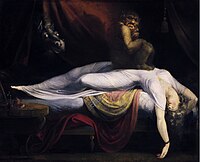
Belum ada Komentar untuk "Dia Visiting Committee of European Sculpture and Decorative Arts Logo"
Posting Komentar